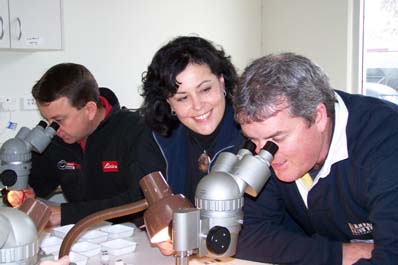Harvest puts grains biosecurity under the microscope
Media Release: 25 November 2009

However, as growers constantly monitor grain quality from the farm gate through to the delivery site, they are helping to maintain the biosecurity of the grains industry.
Judy Bellati, South Australia’s Grains Biosecurity Officer with Primary Industry and Resources SA (PIRSA), is part of the National Grains Industry On-farm Biosecurity Program, working with growers and service providers to raise awareness and provide education about grains biosecurity.
“Biosecurity is emerging as a major economic, environmental and social concern.”
“As an industry we are being expected to provide more and more evidence that our products are free from pests and diseases of biosecurity significance for market access,” Ms Bellati said.
“Australia’s geographic isolation has meant the grains industry has been relatively free of many pests that have wrought havoc on plant industries overseas.”
“This provides a real trade benefit for the Australian grains industry in securing market access.”
Ms Bellati, who will speak on grains biosecurity at the first international Global Biosecurity Conference in Brisbane early next year, said biosecurity should not be seen as a stand-alone issue.
“Biosecurity information needs to be integrated with other farming-system information and into existing grain extension programs.”
“Through alliances with national programs such as the Grains Research Development Corporation (GRDC) National Invertebrate Pest Initiative (NIPI), a large network of agronomists, farmers and other industry providers are becoming skilled in identifying and monitoring both common and exotic pests to the grains industry.”
“NIPI delivers invertebrate identification workshops and interactive newsletters which encourages reporting of seasonal pests and diseases to assist industry in on-farm surveillance.”
“These dynamic and interactive partnerships in grains extension programs play an important role in the industry by providing an enhanced learning experience and assist in biosecurity awareness and preparedness to ultimately benefit the industry.”
“Biosecurity is the responsibility of every person visiting or working on a farm and it is in the interest of all grain growers to ensure biosecurity risks are minimised by implementing simple biosecurity procedures,” Ms Bellati said.
Understanding the risks of potential biosecurity issues will form the basis of the Threats and Impacts stream of the Global Biosecurity 2010 Conference to be held in Brisbane from 28 February – 3 March 2010.
Global Biosecurity 2010: safeguarding agriculture and the environment is a collaborative partnership between Australian Biosecurity Cooperative Research Centre for Emerging Infectious Disease, Cooperative Research Centre for National Plant Biosecurity and Invasive Animals Cooperative Research Centre.
The conference provides a unique forum for stakeholders from across the biosecurity spectrum, including researchers, industry representatives, policy makers, primary producers and importers/exporters to keep up-to-date on world’s best practice.
The Global Biosecurity 2010 Conference is sponsored by: the Grains Research and Development Corporation (GRDC); the Australian Centre of Excellence for Risk Analysis (ACERA); and the Australian Government’s Australian Quarantine and Inspection Service (AQIS).
Registrations for the conference are now open. Visit www.globalbiosecurity2010.com

Judy Bellati, South Australia’s Grains Biosecurity Officer, at the microscopes at an identification workshop in Western Australia. Ms Bellati will speak on grains biosecurity at the first international Global Biosecurity Conference in Brisbane early next year.
Media contact l Laureta Wallace
P (08) 6250 4561
| Attachment | Size |
|---|---|
| MEDIA RELEASE 25.11.09.pdf | 99.84 KB |

